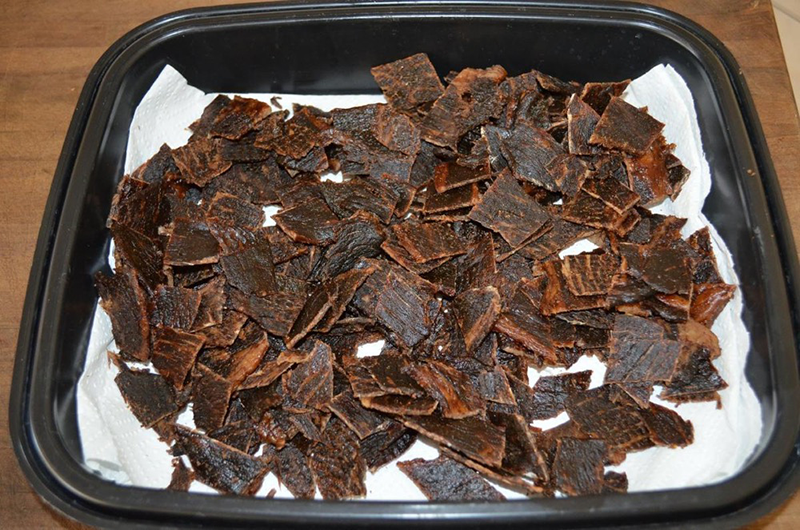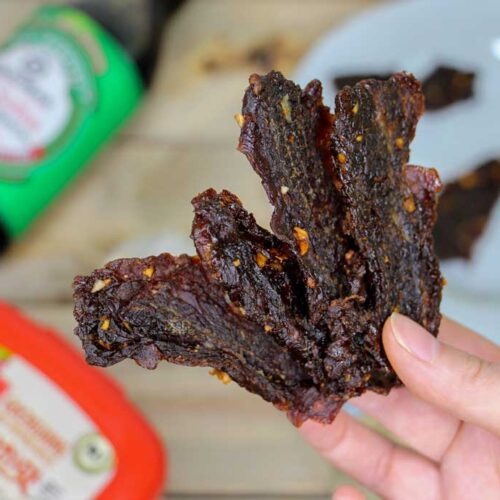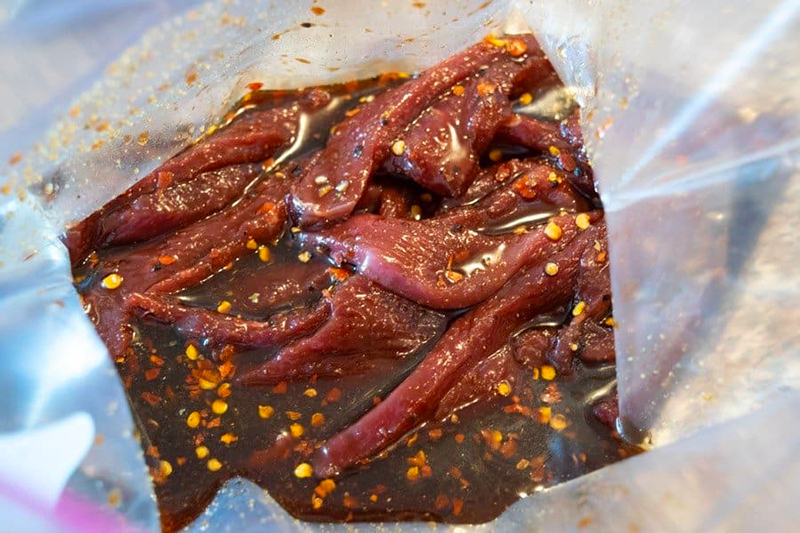
Content Menu
● What is a Food Dehydrator?
● Why Use a Dehydrator for Jerky?
● Choosing the Right Meat
● Preparing the Meat
● Using the Food Dehydrator
● Tips for Perfect Jerky
● Common Mistakes to Avoid
● Flavoring Your Jerky
● Optimal Settings for Dehydrating Beef Jerky
● Storing Your Jerky
● Conclusion
● FAQ
>> 1. What type of meat is best for making jerky?
>> 2. How long should I marinate my meat?
>> 3. Can I use a regular oven instead of a dehydrator?
>> 4. How do I know when my jerky is done?
>> 5. How should I store my homemade jerky?
● Citations:
Making jerky at home is an enjoyable and rewarding process, especially when using a food dehydrator. This guide will walk you through the steps of using a food dehydrator to create delicious beef jerky, including tips on preparation, marinating, and drying. By the end of this article, you'll be equipped with all the knowledge you need to make your own jerky at home.

What is a Food Dehydrator?
A food dehydrator is an appliance designed to remove moisture from food, which helps preserve it. By using low heat and circulating air, dehydrators effectively dry out fruits, vegetables, and meats while retaining their flavor and nutritional value. When it comes to making jerky, a dehydrator is particularly useful because it allows for even drying at controlled temperatures.
Why Use a Dehydrator for Jerky?
Using a dehydrator has several advantages over traditional methods such as ovens or smoking:
- Controlled Temperature: Dehydrators maintain a consistent temperature, crucial for safely drying meat.
- Even Drying: The airflow design ensures that every piece of meat dries uniformly, preventing undercooked spots.
- Energy Efficient: Dehydrators generally consume less energy than running an oven for several hours.
Choosing the Right Meat
When making jerky, the type of meat you choose can significantly affect the flavor and texture. Here are some popular options:
- Beef: The most common choice; cuts like flank steak or top round are ideal due to their low-fat content.
- Pork: Can be used but should be cooked to a safe internal temperature before dehydrating.
- Turkey or Chicken: Lean poultry can also make excellent jerky but requires careful handling to avoid contamination.
Preparing the Meat
1. Selecting the Cut: Choose lean cuts of meat. Trim off any visible fat as fat can spoil faster than lean meat.
2. Slicing: Slice the meat into thin strips (about 1/8 inch thick). For traditional jerky, cut against the grain for tenderness or with the grain for chewier jerky.
3. Marinating: Marinate your meat to enhance flavor. A basic marinade might include soy sauce, Worcestershire sauce, garlic powder, onion powder, black pepper, and brown sugar.
- Marinating Time: Ideally, marinate for at least 4 hours; overnight is best for deeper flavor absorption.
Using the Food Dehydrator
Once your meat is prepared and marinated, it's time to use the dehydrator.
1. Preheat the Dehydrator: Some models require preheating—set it to 160°F (71°C) for meat.
2. Arrange the Meat: Place the marinated strips in a single layer on the dehydrator trays. Ensure they do not overlap to allow proper air circulation.
3. Dehydrate: Set your dehydrator to 160°F (71°C) and let it run for about 4-6 hours. Check periodically to ensure even drying.
- Testing for Doneness: The jerky should bend without breaking and have no moisture when torn apart.
4. Cooling and Storing: Once done, let your jerky cool completely before storing it in airtight containers or vacuum-sealed bags.
Tips for Perfect Jerky
- Use Curing Salt: Adding curing salt can enhance flavor and shelf life by preventing bacterial growth.
- Experiment with Flavors: Try different marinades and spices to find your favorite combinations.
- Rotate Trays: If your dehydrator has multiple trays, rotate them halfway through drying for even results.
Common Mistakes to Avoid
- Not trimming enough fat from the meat can lead to spoilage.
- Overcrowding trays can prevent proper air circulation.
- Not checking for doneness regularly can result in under-dried or over-dried jerky.

Flavoring Your Jerky
While traditional beef jerky often relies on simple marinades, there are countless ways to infuse unique flavors into your jerky:
- Teriyaki Jerky: Combine soy sauce, brown sugar, garlic powder, ginger powder, and rice vinegar. Marinate overnight for a sweet and savory profile.
- Spicy Chili Jerky: Add chili powder, cayenne pepper, and hot sauce to your marinade for a spicy kick that will satisfy heat lovers.
- BBQ Jerky: Mix BBQ sauce with Worcestershire sauce and add a touch of honey for sweetness. This gives a smoky flavor reminiscent of summer cookouts.
Optimal Settings for Dehydrating Beef Jerky
The ideal temperature and time can vary based on factors such as the thickness of the meat slices and personal preference.
In general:
- Set the temperature between 145°F and 160°F (63°C and 71°C) to kill harmful bacteria while preserving texture.
- Drying time typically ranges from 4 to 6 hours but may require adjustments based on slice thickness and humidity levels in your environment[1][3].
Storing Your Jerky
Proper storage is crucial for maintaining flavor and preventing spoilage:
- Store cooled jerky in airtight containers or vacuum-sealed bags.
- Keep it in a cool, dark place; refrigeration can extend shelf life significantly.
- For longer storage periods (up to several months), consider freezing your jerky.
Conclusion
Making beef jerky in a food dehydrator is straightforward and allows you to customize flavors while ensuring safety through proper drying techniques. With practice, you'll perfect your method and enjoy delicious homemade jerky as a healthy snack option.
The process not only provides you with tasty snacks but also allows you to control ingredients—making it healthier than many store-bought options filled with preservatives.

FAQ
1. What type of meat is best for making jerky?
Lean cuts of beef such as flank steak or top round are ideal due to their low-fat content.
2. How long should I marinate my meat?
Marinating overnight yields the best flavor; however, marinating for at least 4 hours is recommended.
3. Can I use a regular oven instead of a dehydrator?
Yes, but using an oven might not provide as consistent results as a dehydrator due to varying temperatures and airflow.
4. How do I know when my jerky is done?
Jerky should bend without breaking and have no moisture when torn apart; it typically takes about 4-6 hours at 160°F (71°C).
5. How should I store my homemade jerky?
Store in airtight containers or vacuum-sealed bags in a cool, dry place; refrigeration can extend shelf life further.
Citations:
[1] https://septree.com/blogs/news/5-recipes-to-make-beef-jerky-with-your-dehydrator
[2] https://www.youtube.com/watch?v=Wj-xTmebJBQ
[3] https://www.chowhound.com/1717253/mistakes-avoid-cooking-beef-jerky/
[4] https://www.foxvalleyfoodie.com/homemade-beef-jerky/
[5] https://peopleschoicebeefjerky.com/blogs/news/how-to-make-beef-jerky-in-a-dehydrator
[6] https://www.tastingtable.com/1671930/mistakes-avoid-dehydrator/
[7] https://www.jerkyholic.com/how-to-make-beef-jerky-with-a-dehydrator/
[8] https://www.allrecipes.com/recipe/142948/docs-best-beef-jerky/
[9] https://www.reddit.com/r/dehydrating/comments/f030f3/made_some_mistakes_while_making_jerky_for_first/
[10] https://www.dehydratorsamerica.com/post/jerky-food-safety











